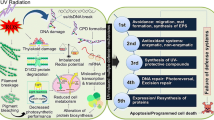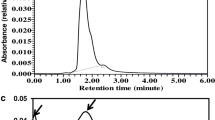Abstract
Despite knowledge of the existence of the pigment called scytonemin for over 100 years, its structure has remained unsolved until now. This pigment, the first shown to be an effective, photo-stable ultraviolet shield in prokaryotes, is a novel dimeric molecule (molec. wt. 544) of indolic and phenolic subunits and is known only from the sheaths enclosing the cells of cyanobacteria. It is probable that scytonemin is formed from a condensation of tryptophan-and phenylpropanoid-derived subunits. The linkage between these units is unique among natural products and this novel ring structure is here termed the ‘scytoneman skeleton’. Scytonemin absorbs strongly and broadly in the spectral region 325–425 nm (UV-A-violet-blue, with an in vivo maximum at 370 nm). However, there is also major absorption in the UV-C (λ max=250nm) and UV-B (280–320 nm). The pigment has been recently shown to provide significant protection to cyanobacteria against damage by ultraviolet radiation. The pigment occurs in all phylogenetic lines of sheathed cyanobacteria and possibly represents a UV screening strategy far more ancient than that of plant flavonoids and animal melanins. How diverse organisms deal with UV radiation is considered of vital importance to global ecology.
Similar content being viewed by others
References
Garcia-Pichel, F., and Castenholz, R.W., J. Phycol.27 (1991) 395.
Garcia-Pichel, F., Sherry, N.D., and Castenholz, R.W., Photochem. Photobiol.56 (1992) 17.
Nägeli, C., Neue Denkschr. allg. schweiz. Ges. ges. Naturw.10 (1849) 1.
Several other colorless compounds, probably mycosporine-related amino acids, have been detected in cyanobacteria (Garcia-Pichel, F., and Castenholz, R.W., Appl. Environ. Microbiol.59 (1993) 163; Scherer, S., Chen, T.W., and Böger, P., Plant Physiol.88 (1988) 1055). These may serve a sunscreen function but their chemical structures are still unknown.
Fritsch, F.E., The Structure and Reproduction of the Algae, vol. II. Cambridge University Press, Cambridge 1945.
Turian, G., Saussurea16 (1985) 43.
Nägeli, C., and Schwenderer, S., Das Mikroskop, 2nd ed., W. Englemann Verlag, Leipzig 1877. The term ‘scytonemin’ (sensu Nägeli) has been widely used since then (see citations 1, 4, 5, 8 and Gemsch, N., Ber. schweiz. bot. Ges.53 (1943) 121). However, G.L. Helms, R.E. Moore, W.P. Niemczura, and G.M.L. Patterson (J. org. Chem53 (1988)_1298) extracted a novel cyclic peptide from a cyanobacterium and gave it the name ‘scytonemin A’; the authors were apparently unaware of the prior use of the term scytonemin. H. Kylin contended that scytonemin was actually two different pigments that he named fuscochlorin and fuscorhodin (Kylin, H., Hoppe-Seyler's Z. physiol. Chem.166 (1927) 33; Kylin, H., Fysiogr. Sällsk. Förhandl.7 (1937) 131). We subsequently established1 that Kylin's fuscochlorin was likely scytonemin sensu Nägeli, whereas fuscorhodin corresponded to a reduced form of scytonemin which in natural samples forms as a result of exposure to low redox potentials due to anoxia. Therefore, the term scytonemin, having precedence, is retained for both forms of the pigment.
Knoll, A.H., Swett, K., and Mark, J., J. Paleont.65 (1991) 531.
Horodyski, R.J., Bauld, J., Lipps, J.H., and Mendelson, C.V., in: The Proterozoic Biosphere. Eds J.W. Schopf and C. Klein. Cambridge University Press, New York 1992.
Awramik, S.M., Photosynth. Res.33 (1992) 75.
Kasting, J.F., Science259 (1993) 920.
Tripathi, S.N., and Talpasayi, E.R.S., Curr. Sci.49 (1980) 31.
During the many meetings of the Precambrian Paleobiology Research Group — Proterozoic (PPRG-P), which led to the publication of the interdisciplinary volume, The Proterozoic Biosphere (see citations 11, 12), this possibility was mentioned frequently. Scytonemin has been identified in members of all phylogenetic branches of the cyanobacteria1, lending credibility to the hypothesis that the ability to synthesize this pigment was also present in the ancestral line in the Precambrian. It has been suggested, without foundation, that scytonemin aids in the preservation of sheaths by chelating iron or other heavy metals (Golubic, S. and Hofmann, H.J., J Paleont50 (1976) 1074). Scytonemin, however, is not related to the iron complexing extracellular pigment-peptide moiety isolated fromAnabaena by A.E. Walsby, Brit. Phycol. J.9 (1974) 371, 383.
Because of the occurrence of buried sheaths and the persistence of reduced scytonemin at depth within anoxic sediments and mats1, it is possible that identifiable derivatives may eventually be detected in Precambrian stromatolites if indeed this pigment existed then (see Boon, J.J., and de Leeuw, J.W., in: The Cyanobacteria, p. 471. Eds P. Fay and C. Van Baalen. Elsevier, Amsterdam 1987).
Reduced scytonemin shows UV (THF)λ max=246 (30,000), 276 (14,000), 314 (15,000), 378 (22,000), 474 (14,000), 572 (broad shoulder, 7,600); for NMR data, see table.
Bernart, M., and Gerwick, W.H., Phytochemistry29 (1990) 3697; Kinnel, R.B., and Scheuer, P.J., J. org. Chem.57 (1992) 6327; Morales-Rios. M.S., and Joseph-Nathan, P., Magn. Res. Chem.27 (1989) 75.
Reduced scytonemin (53 mg in 70 ml EtOAc) was cooled to −78°, then O3 was bubbled through the solution for 10 min. Dimethyl sulfide was added dropwise (1 ml) to the cold solution and then allowed to react at RT for 5h. The concentrated product was purified by first flash (5∶95 MeOH/CHCl3), then Sephadex LH-20 chromatography (1∶1 EtOAc/MeOH) to give the ozonlysis product (5.3 mg). This was recrystallized from 1∶1 EtOAc/MeOH to yield orange needles (m.p. 130° darkening of crystals, 225° dec.) showing UV (THF)λ max=244 (16,000), 276 (13,000), 296 (14,000), 372 (28,000); FT-IR (neat) 3228 (br), 1733, 1664, 1599, 1584, 1508, 1452, 1282, 1235, 1162 cm−1; for NMR data see table.
While molecular modeling (Chem 3D Plus) of scytonemin suggested the possibility that the molecule could be chiral due to hindered rotation about the single bond joining the two halves, circular dichroism analysis showed scytonemin to be optically inactive.
Prota, G., in: Advances in Pigment Cell Research, p. 101. Ed. J.T. Bagnara, A. Liss, New York 1988.
Kollias, N., Sayre, R.M., Zeise, L., and Chedakel, J., J. Photochem. Photobiol. B (Biol.)9 (1991) 135.
Takahashi, A., Takeda, A.K., and Ohnishi, T., Plant Cell Physiol.32 (1991) 541.
Tevini, M., Braun, J., and Fieser, G., Photochem. Photobiol.53 (1991) 329.
Author information
Authors and Affiliations
Rights and permissions
About this article
Cite this article
Proteau, P.J., Gerwick, W.H., Garcia-Pichel, F. et al. The structure of scytonemin, an ultraviolet sunscreen pigment from the sheaths of cyanobacteria. Experientia 49, 825–829 (1993). https://doi.org/10.1007/BF01923559
Received:
Accepted:
Published:
Issue Date:
DOI: https://doi.org/10.1007/BF01923559




